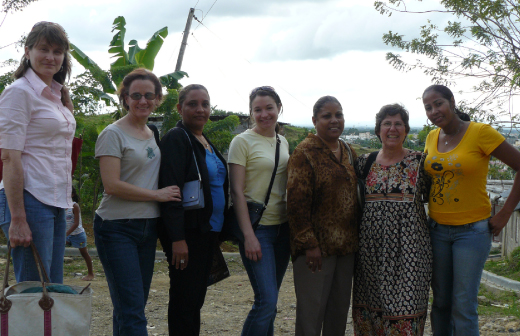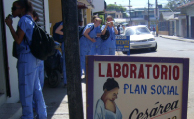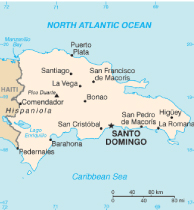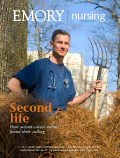Solving the Dominican paradox

In the Dominican Republic, faculty member Jenny Foster (second from right) and her team interviewed new mothers and men who had lost their partners or children after birth.
Nurses help their Dominican colleagues prevent maternal death.
In a country twice the size of New Hampshire, women were dying at an alarming rate after giving birth. As small as the Caribbean country of the Dominican Republic was, its maternal death rate was 15 times that of the United States.
While many developing countries have high maternal death rates because of lack of resources, the Dominican Republic was considered a paradox. It had a large network of public hospitals with trained staff that pregnant women used. In fact, approximately 97% of pregnant women gave birth in hospitals, where doctors handled births by cesarean section, and nurses, the vaginal births. But these women were still dying.
The nurses at one public hospital in the third largest city of San Francisco de Macorís decided to do something about the problem. They had had six deaths in the span of six months, compared with three deaths in the same time period the year before. They contacted the Universidad de Puerto Rico for help. The university sent a team of nurse-midwives to assess the problem, and the Dominican nurses received an interesting evaluation. “We think you know what the problem is,” they were told.
The nurses themselves did identify the problem early on. They said patient follow-up was their biggest weakness in patient care. Often, family members were the ones who recognized a problem and alerted the nurses. The nurses told the assessment team that they were stretched thin—too many patients, too few nurses—and felt caught in a cycle of reacting to problems as they arose instead of anticipating and addressing problems proactively. Help us break the cycle, they asked.
|
The nurses have more self-confidence and are more motivated. They quality of their patient reports is better, leading to more respect from doctors. --Jenny Foster |
||||
One member of the assessment team called Jenny Foster, a midwife who has a doctorate in medical anthropology and who came to the School of Nursing in 2007. The team member and Foster had worked together in clinical practice at the University of Massachusetts. Together, they came up with a plan that would be led by the Dominican nurses and the community.
Change can't come just from the health side, Foster says. It also has to come from the community for it to be sustainable.
The initial assessment pointed out some other areas for improvement, such as updating knowledge and skills. The nurses attended a number of educational conferences over three years to learn how to use a fetoscope, conduct a physical, and monitor the progress of labor. The main issue, though, still was the need to increase proactive behavior.
“It wasn’t about knowledge,” Foster says. “They knew what to look for, with bleeding, for example. What they didn’t do is follow up with women on a routine basis.”
The Dominican nurses then trained volunteers to be doulas, had a new bathroom installed on the labor ward, and purchased supplies, including fabric to sew curtains for patient privacy. Still, pregnant women from rural areas would come into the hospital very ill and die.
 |
About 60% of births in the Dominican Republic are by cesarean section, and doctors with private clinics routinely advertise their services, as Emory nursing students saw last year. |
|||
The nurses wanted to know if women understood dangerous symptoms during pregnancy, and that question formed the basis of the next phase of Foster’s research. Health care providers made up one-half of the research project; the other half was the community. Foster and her team recruited people, including men who lost their partners or children after birth, for interviews and focus groups. The team currently is working on assessing communication between nurse and patient and seek to publish their work in Spanish nursing journals.
“The community was involved in every part of research,” Foster says. “They helped not only with the collection of research but also thinking of questions and analyzing data.”
Today, five years after the start of the project, the Dominican nurses have improved their clinical skills and job satisfaction. The hospital had no maternal deaths in 2008.
“The nurses have more self-confidence and are more motivated,” Foster says. “The quality of their patient reports is better, leading to more respect from doctors. These points are so important in locations where there are huge shortages of supplies and resources.”
 |
By ComparisonAverage number of maternal deaths per 100,000 births: United States: 10 Dominican Republic: 150 Afghanistan: 1,800 Source: United Nations, 2005. |
|||


